Mass Transit Musings (2004-2008)
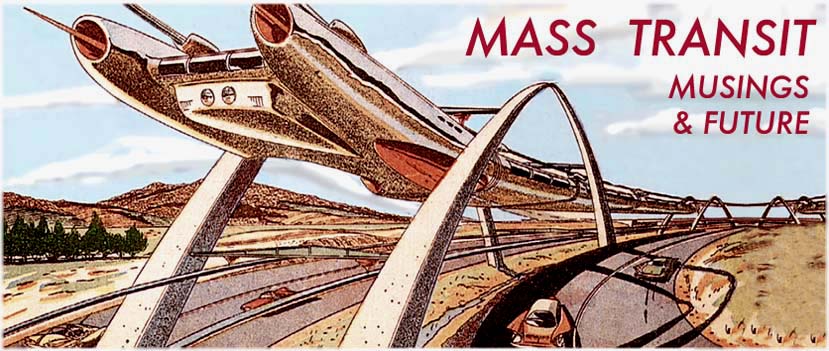
More recent mass transit musings can be found here.
I Wish I'd Written This ... but it's from Randal O'Toole, aka The Antiplanner: "Light rail will not be the death of America. But the attitude behind light rail - that we can and should spend billions on every feel-good project that comes along without evaluating its cost effectiveness - may very well be the death of the democracy and freedom we cherish." (hat tip - American Digest) (posted 8/22/08, permalink)
Interesting Quotes from transit guru and public policy consultant Wendell Cox in an interview with Bill Steigerwald: "For most transit agencies in the United States, if they were to write a mission statement that is reflective of what they do, they would indicate that they exist for the purpose of serving their employees and vendors."
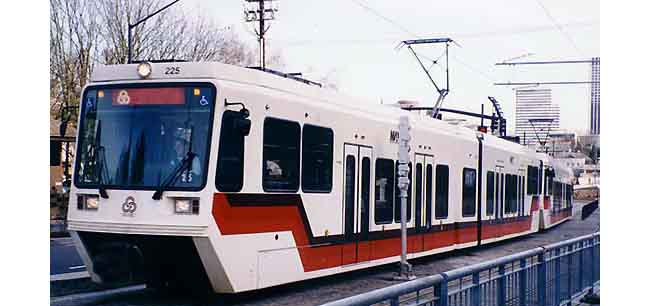
And: "Mass transit expenditures have gone up more than 300 percent adjusted for inflation since 1970 and ridership has gone up less than 20 percent. There is no other sector of the economy, including health care, where I can find escalation even close to that." (posted 6/9/08, permalink)
Light Rail Boondoggle: "Three light-rail lines have been added to L.A. county's transit system in the last 20 years. Together, these cost $2.5 billion in capital costs, they serve about 125,000 passengers per day and account for a fiscal loss of approximately $252 million per year - if one acknowledges that capital costs are real, something that transit operators and boosters often neglect."
"So if you do the math, the capital costs alone come to $20,000 per daily rider (and that's making a generous assumption about how many "regular" riders there are). Add in the annual operating loss, and it would have been cheaper to buy each rider a compact car and a full tank of gasoline each week for the rest of his life."
All of this for a negligible decrease in traffic congestion: In no city in the country does light rail ridership equal more than 1.2 percent of travel.
How much does it cost taxpayers to move one person one mile? About six cents for freeways and $2.75 for light-rail. Therefore, light rail costs 40 times more than freeways. The person-mile cost of buses is $1.59 - still much more than roads but considerably less than rail. (posted 1/16/08, permalink)
Thinking Outside The Box: A recent Columbian news article caught my eye. It had this opening sentence: "Mass transit may not wind up on the new Columbia River bridge at all, but under it." Planners for the new Columbia River bridge are looking at a quirky design characteristic dubbed "transit-in-a-box." It means running mass transit lanes - be they for buses or light rail - under the road and inside the main structure of the bridge.

A little background is in order here. The Columbia River Interstate Bridge is obsolete. Originally built in 1917, this is the only lift bridge on busy Interstate 5 between Mexico and Canada. Over 130,000 vehicles cross the bridge on an average day and for four-five hours each day, the bridge operates at or beyond nameplate capacity. The bridge is frequently a bottleneck which impacts both traffic on the freeway, as well as on the river. The lift takes 10 minutes to open and does so between 10 and 20 times per month, which causes nightmarish traffic backups. The bridge is also an eyesore - ugly and decrepit.
The Oregon and Washington state Departments of Transportation have been jointly studying how to replace the bridge for several years now. One of the problems to be faced is that a tall, non-lift bridge will require vastly increased approach ramps, wiping out much of downtown Vancouver and restricting access to the Hayden Island shopping district in North Portland. The proposed 'transit-in-a-box' (TIB) concept adds another 15-20 feet to the deck height, making the approaches even longer and more detrimental.
This silly idea is indicative of how the bridge committee thinks. While the 'need' for isolated mass transit areas on/over/under the bridge has never been properly documented, the movers and shakers want mass transit.
The article states, "TIB means the trains will be fitted right into the design of a concrete box bridge. No examples can be found in North America The design has been used a few times in Asia and Europe, including the Reichsbrucke bridge in Vienna, the Nuselsky Bridge in Prague and the approach to the Tsing Ma bridge in Hong Kong."
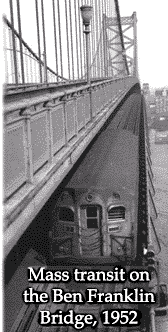 If the planners would look closer, they would find the answer on the Ben Franklin Bridge in Philadelphia. The bridge, completed way back in 1926, was designed to accommodate rail transit lines hanging off the sides of the bridge. The rail lines were above the substructure, so the approaches were no lengthier than a conventional bridge. The lines were below the deck sightline, so the view of the river for motorists and pedestrians would be unimpaired. Even the train riders would experience river views. If the planners would look closer, they would find the answer on the Ben Franklin Bridge in Philadelphia. The bridge, completed way back in 1926, was designed to accommodate rail transit lines hanging off the sides of the bridge. The rail lines were above the substructure, so the approaches were no lengthier than a conventional bridge. The lines were below the deck sightline, so the view of the river for motorists and pedestrians would be unimpaired. Even the train riders would experience river views.
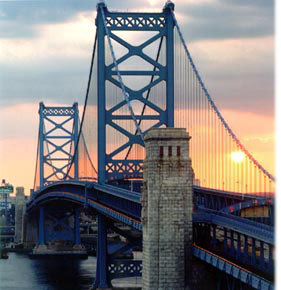 In 1936, the new bridge line opened with subways in Camden, NJ and Philadelphia connected by the bridge transit system. Now called PATCO, the line's trackage has been greatly expanded into South Jersey. PATCO is the only U.S. mass transit system which consistently makes an operating profit each year - a feat never accomplished by TriMet (Oregon) or C-Tran (Washington). In 1936, the new bridge line opened with subways in Camden, NJ and Philadelphia connected by the bridge transit system. Now called PATCO, the line's trackage has been greatly expanded into South Jersey. PATCO is the only U.S. mass transit system which consistently makes an operating profit each year - a feat never accomplished by TriMet (Oregon) or C-Tran (Washington).
The Ben Franklin Bridge, now painted a bright blue and restored to its original glory, is the defining structure in the historic Delaware River area of Philadelphia. When first completed, this attractive bridge was the largest suspension bridge in the world. As the Ben Franklin Bridge web page states, "Great cities have great bridges."
But, for Portland/Vancouver, a bridge is not the only solution.
At a business lunch three years ago, I proposed a tunnel to replace the Columbia River bridge. This would remove the old eyesore and provide a sweeping view of the river from both shores. Unbeknownst to me, one of my dining companions was a member of the bridge replacement commission. "You know, no one has ever brought up the idea of a tunnel," he confessed. Too busy thinking-inside-the-box (TIB), I guess.
I suggested that the tunnel be financed by auctioning the waterfront rights to the highest tribal bidder and let them build a casino and resort complex on the water's edge. Make the winning tribe responsible for construction and upkeep costs for the toll-free tunnel. In exchange, the casino would get it a world-class, high-traffic casino location with its own exclusive exit and, heck, even its own transit stop! (posted 12/7/07, permalink)
Myths About Cars, Sprawl and Mass Transit: The Washington Post has an informative article about the true impact of the automobile, noting that "suburban sprawl and automobiles are rapidly acquiring a reputation as scourges of modern American society. Sprawl, goes the typical indictment, devours open space. ... And cars are the evil co-conspirator - the driving force, so to speak, behind sprawl."
"Some claim that Europeans have developed an enlightened alternative. Americans return from London and Paris and tell their friends that everyone gets around by transit. But tourists tend to confine themselves to the central cities. Europeans may enjoy top-notch transit and endure gasoline that costs $5 per gallon, but in fact they don't drive much less than we do. In the United States, automobiles account for about 88 percent of travel. In Europe, the figure is about 78 percent. And Europeans are gaining on us."
The article notes that public transit "has been on the slide for well more than half a century. Even though spending on public transportation has ballooned to more than seven times its 1960s levels, the percentage of people who use it to get to work fell 63 percent from 1960 to 2000 and now stands at just under 5 percent nationwide. Transit is also decreasing in Europe, down to 16 percent in 2000."
The Post article also makes this point: "Air quality has been improving for a long time. More stringent regulations and better technology have allowed us to achieve what was previously unthinkable: driving more and getting cleaner. Since 1970, driving - total vehicle miles traveled - has increased 155 percent, and yet the EPA reports a dramatic decrease in every major pollutant it measures. Although driving is increasing by 1 to 3 percent each year, average vehicle emissions are dropping about 10 percent annually. Pollution will wane even more as motorists continue to replace older, dirtier cars with newer, cleaner models."
Yes, yes, we all love to use mass transit when touring Europe. Just watch a few episodes of Rick Steves on PBS and you'll be positively drooling over the romance of traveling on an exotic rail line, chatting with colorful local proles while taking in the sights through sparkling clean windows.
Indeed. In 2000, we visited London, Edinburgh, Glasgow and Paris and never rented a car. We relied almost exclusively on the fine public transit systems in those cities. And had a delightful time while wearing our Ecco walking shoes and toting backpacks. Same for our visit to D.C. in 2004. But we weren't using the transit systems during peak periods and the weather was generally nice.
Try getting sardine-packed into a dank subway car with 273 sweaty humans at rush hour in August. Or waiting for a filthy overcrowded bus when it's cold, dark and pouring rain. Not so romantic. That's why people use cars. And will continue to do so.
Mass transit. Nobody wants it. Because it is designed for the masses. Too Karl Marx-y, you know. (posted 2/7/07, permalink)
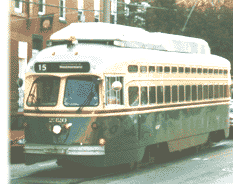 The Return Of The 15: The Route 15 trolley has returned to Girard Avenue in North Philadelphia. The Return Of The 15: The Route 15 trolley has returned to Girard Avenue in North Philadelphia.
The trolleys, which will run from 63rd and Girard to Richmond and Westmoreland, have been rebuilt and now have air conditioning and heating. The cars are also now equipped with wheelchair lifts and restraints. Trolley service on the 15 line had been stopped in 1992.
I'm not generally a fan of mass transit - especially out here where population density is low. But, in high-density areas like urban Philadelphia, mass transit makes a lot of sense. Nevertheless, it was an expensive undertaking - the Southeast Pennsylvania Transit Authority spent $88 million upgrading the Route 15 for continued trolley service, including $1.8 million for each of the 18 1947 PCC trolleys that were rebuilt for use on the line. The large roof blister on top of the trolley is for the air conditioning system, something not supplied in '47.
I used to ride the ol' 15 up Girard Ave. to high school every day. I'm glad that Philly still calls its vehicles 'trolleys' rather than that dreaded, contrived 'Light Rail Vehicle' designation. (posted 9/8/05, permalink)
Urban Planning For Dummies: The city of Vancouver, Washington is upset that its downtown transit mall has become a hang-out for unsavory characters. The mayor complains that it does not fit with the new image of a gentrified downtown - something he hopes to have once he gets rid of all the pawn shops and seedy bars. The mayor expressed surprise that most bus riders didn't stop to shop in the fine boutiques of Main Street, rather, they just hopped on other buses. And went elsewhere. (Well, duh.)
Transit malls (once known simply as bus terminals) have never attracted dukes and debutantes. Look at old photos and you'll see unshaven men skulking past a line-up of buses parked near a run-down tavern or arcade.
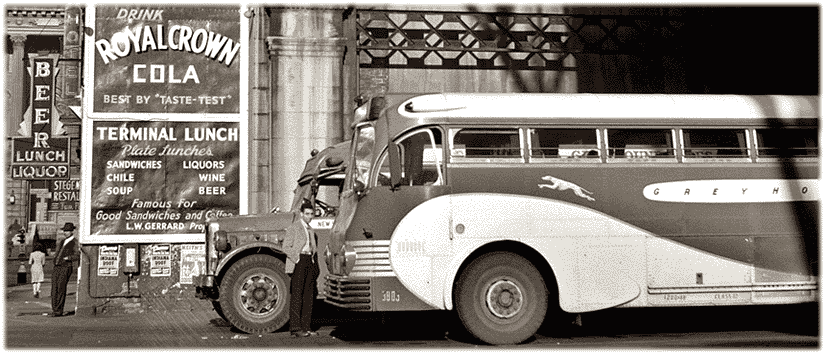
Grab a book about old New York and look at the photos of the well-heeled folks at Grand Central Station. Compare such people with old photos of the vagrants loitering in the Port Authority bus terminal photos. I rest my case.
The problem with Vancouver (and many other cities) is that one can't have a Gentrified Section without having a down-at-the-heels counterpart on the other side of the tracks (perhaps the lower side of the tracks in the five-year flood plain). A place where all seedy establishments are located - CrapTown. It's filled with railroad yards, run-down houses, adult video stores, bong supply establishments, dumpy apartment buildings, pawn shops, rent-by-the-week furniture stores, 'No Bad Credit' used car lots and methadone clinics. And bus terminals. A lively bustling neighborhood - streets filled with tattooed hookers, staggering drunks and mouth-breathing Troglodytes. CrapTowns make communities more efficient allowing police efforts to be concentrated where they will do the most good. Vancouver needs a geographically-designated CrapTown. (I nominate Lower River Road.)
Gerald Baugh, Vancouver's business development manager, shared his (Utopian) vision for making the community a success - a "pedestrian-friendly environment that forces you to get out of your car. You don't want too much parking." Screw that, Gerald. It rains too much here. My vision for a successful Vancouver would be lots of parking spaces and an aggressive police force driving street people elsewhere. My proposed slogan: "Vancouver - kinda like Portland, except more parking and no bums." Now that's a formula for success!
And a couple of other things: 1. Rename the city Fort Vancouver so visitors don't think they're in Canada, 2. Tear down that butt-ugly Interstate bridge and replace it with a tunnel. An artsy one, lined with whimsical fish tiles and a mermaid bas relief or two. And cool-looking light fixtures. (posted 2/25/05, permalink)
Ice Pussies: In January 2005, our area got an ice storm. A mild one. But the roads were chaos (because people were ill-prepared, poorly-equipped idiots). In Portland, several bus routes were canceled or delayed. Last year, we had a much worse storm. The entire trolley and light rail system was out-of-service for three days! "We have ice on the wires and there is snow on the tracks," said a spokesman. Well, duh! Apparently, they have no ice or snow removal equipment. (In other cities, most trolleys have ice-breakers which are installed on the forward pole when a storm is anticipated.) I grew up in Philadelphia where there were real storms. Big storms! But the trolleys and El were almost always kept running because they had dedicated equipment to handle snow and ice chores. In those days, part of National City Lines contract with the city of Philadelphia stipulated that they had to keep all bus and trolley routes open. And they did so. Not in Portland: "It's too hard!" Portland, Oregon - The City of Wusses.
Clang, Clang, Clang: 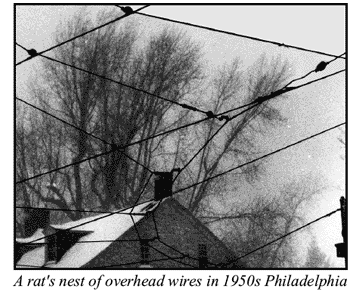 James Lileks has bemoaned the return of the trolley to Minneapolis: "Heading into the office today I was startled to see the poles - ten per block, tall and gray, ugly lumps hanging from the wires that laced the poles together. ... And so the intersections now have these latticework constructs, these anal-retentive dreamcatchers, these tic-tac-toe puzzles pasted over your view of the sky." He added recently that "the operating budget requires an $11K subsidy per passenger per year." Ouch! James Lileks has bemoaned the return of the trolley to Minneapolis: "Heading into the office today I was startled to see the poles - ten per block, tall and gray, ugly lumps hanging from the wires that laced the poles together. ... And so the intersections now have these latticework constructs, these anal-retentive dreamcatchers, these tic-tac-toe puzzles pasted over your view of the sky." He added recently that "the operating budget requires an $11K subsidy per passenger per year." Ouch!
The 'romance' of trolleys blinds people to their disadvantages - expensive to build or modify a line or route, inflexible, unable pull to side of the road for passengers to embark/disembark, the overhead wires, the nightmare when one breaks down and on and on. When it used to cost a few hundred thou to construct a line, they were called 'trolleys.' Now that the cost is in the billions, they are referred to as 'light rail vehicles' or 'LRVs.' Sounds more sophisticated and NASA-like. I guess bureaucrats think that fancy names and acronyms helps justify the outrageous price. Better and smarter to use low-emission buses, in my opinion. They're cheaper (both capital investment and operating costs) and more flexible.
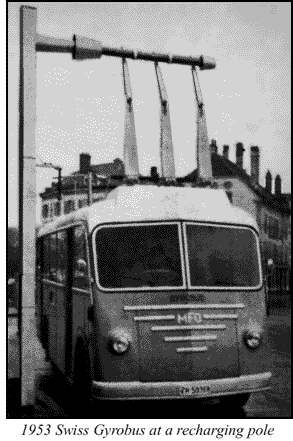 In the 1950s, the Swiss used to have a flywheel-powered bus. It recharged (spun-up the electric motor) from electrical poles along the route - took 30 seconds or so. Zero pollution. No overhead wires either. It was the Gyrobus made by the Swiss firm, Oerlikon. The Gyrobus had a 3,300-pound, steel flywheel located beneath the floor spinning at 3,000 rpm. The flywheel spun the motor's armature, turning it into a generator. In the 1950s, the Swiss used to have a flywheel-powered bus. It recharged (spun-up the electric motor) from electrical poles along the route - took 30 seconds or so. Zero pollution. No overhead wires either. It was the Gyrobus made by the Swiss firm, Oerlikon. The Gyrobus had a 3,300-pound, steel flywheel located beneath the floor spinning at 3,000 rpm. The flywheel spun the motor's armature, turning it into a generator.
The electricity it produced powered a second electric motor, which drove the bus wheels. Every three to four miles on the route there were posts where the flywheel was recharged - three poles on the bus were raised to make contact with a three-phase alternating current source.
There were 27 Gyrobuses in Yverdon, Switzerland and, later, 17 in Leopoldsville, Zaire. Other flywheel buses have been tested recently in Hong Kong and Australia, using a more high-tech flywheel. And a flywheel-powered trolley has been in service in Bristol, England since 1998. There are no overhead wires. It draws power from low voltage electric charging points at passenger stops.
The electricity powers an electric motor that spins a 1,000-pound flywheel. The vehicle, which has 20 seats and room for 14 standing passengers as well, can travel up two miles before it needs to recharge its flywheel.
I think much of the spending on mass transit makes no economic sense. And is a waste of tax dollars. In smaller, less-population-dense cities, public transit is 'pushed' by Greenies with a political agenda. Or politicians with a Greenie agenda. But, in their quest for more energy-efficient, earth-friendly transit systems, why aren't these people looking at flywheel-powered solutions? (permalink)
Mess Transit: C-Tran, Clark County, Washington's transit agency, wants another sales tax hike and, in 2004, has put forth a ballot measure for voters to approve. The measure would double the existing 0.3 percent transit sales tax. If it fails, C-Tran will cut the number of routes, reduce frequency of service and eliminate weekend buses.
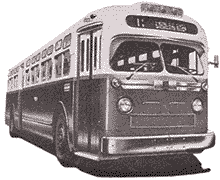 The commuter bus routes to Portland (which would be cut if the measure fails) keep drivers off the clogged interstates, said Val Ogden, a former state legislator. "For every bus that's there, you can take 30 to 40 cars off the road," Ogden said. This statement makes no sense. If the routes are that popular, why would they be cut? Wouldn't the less-utilized routes, such as the ones I always see - with two or three lonely riders on a big herkin', diesel-fume-spewing bus, be the ones to get the axe? If not, the regional transit management should be fired for incompetence. (Update: The tax measure failed in the 11/04 election.) The commuter bus routes to Portland (which would be cut if the measure fails) keep drivers off the clogged interstates, said Val Ogden, a former state legislator. "For every bus that's there, you can take 30 to 40 cars off the road," Ogden said. This statement makes no sense. If the routes are that popular, why would they be cut? Wouldn't the less-utilized routes, such as the ones I always see - with two or three lonely riders on a big herkin', diesel-fume-spewing bus, be the ones to get the axe? If not, the regional transit management should be fired for incompetence. (Update: The tax measure failed in the 11/04 election.)
Predictably, at any public meetings about mass transit, riders step forward with bleeding-heart stories - assuring the press of an poignant sound bite. "I'm going to be without my independence and ride to work," said an attorney, who uses a wheelchair.
Oh, pulleeeeeze. I suspect that this lawyer makes very good money at his job. (If not, he should sue for discrimination against the disabled!) If he's good, he probably makes somewhere north of $100,000 per annum. So, if his bus route is cut, he could likely afford to purchase a wheelchair-friendly van. Or hire a limo.
The lawyer neglected to mention that, as a person with limited mobility, he is most likely eligible for special curb-to-curb service for people "who cannot access regular route service and who qualify for service pursuant to the Americans with Disabilities Act (ADA)." The service (C-Van) charges $1.00 per passenger but more than half the people who use it pay nothing. C-Van costs more than $23.00 per passenger to operate and the difference is made up by taxpayers - like you. And me.
Mr. Attorney should know that, in accordance with the Americans with Disabilities Act, transit companies must provide such a paratransit service throughout their operating areas during the same hours that the fixed route service is provided.
On any given day, less than 5% of the population use public transit to get to work. Even over a two-month period, only about 11 percent of the population have used it at all. 69% of riders use public transport either to get to work (54%) or school (15%).
The popularity of public transportation has been affected by changing social and economic forces. In the early 20th Century, ridership grew steadily until the Great Depression. Then it dropped off. During World War II, fuel rationing, tire scarcity and car shortages caused a jump in ridership. After the war, transit usage declined - suburban development and the sprawl created by the new interstate highway system encouraged car ownership. By the 1960s, most privately-owned mass transit systems had gone bust and were taken over by tax-supported government entities.
Today's public transit systems benefit poor people more than anyone else. Those with lower incomes tend to ride mass transit systems "because they value money savings over time savings and convenience" according to C-Tran's own website. Most transit systems only recoup 10-15% or so of their operating expenses from fare revenues. In other words, if public transit became a pay-as-you-go proposition, fares would have to be increased by seven to tenfold.
So, your taxpayer "investment" in creating and operating such mass transit systems is serving a social welfare function. Whether or not this is a 'good' use of your tax dollars is up to you to decide. Your dollars subsidize a small number of users (mostly students and the poor) who are already receiving other subsidies. The Libertarian in me says this is not a good way to spend taxpayer dollars.
If your local transit system wants to take more money out of your pockets, think carefully before you approve. Don't vote based on a bunch of 'woe-is-me' tales. Investigate the facts. Vote with your head. (posted 9/25/04. permalink)
Bureaucratic Idiots: SmarTrip is a permanent, rechargeable fare card offered in D.C. by Metro (aka - Washington Metropolitan Transit Authority). This plastic credit card-like device is embedded with a special computer chip that keeps track of the value of the card. It is used to make ridership easier and build business for the WMTA. So, you'd think they'd want to maker the SmarTrip card as popular as possible. But nooooooooo. (Apologies to the late John Belushi). From Metro's website: "Metro has suspended online SmarTrip card sales. SmarTrip card inventories have dwindled as a result of record card sales in recent weeks." Morons. Print more cards, you idiots! This is why bureaucracy will never overcome entrepreneurship. And another reason why public transit systems operate at a big loss.
We used Metro subway trains to get around Washington during our October 2004 trip. The cars and stations were clean and the personnel were courteous and helpful. So WMTA is doing some things right.
More mass transit musings can be found here.
Other Pages Of Interest
copyright 2004-21 - Joseph M. Sherlock - All applicable rights reserved
Disclaimer
The facts presented on this website are based on my best guesses and my substantially faulty geezer memory. The opinions expressed herein are strictly those of the author and are protected by the U.S. Constitution. Probably.
Spelling, punctuation and syntax errors are cheerfully repaired when I find them; grudgingly fixed when you do.
If I have slandered any brands of automobiles, either expressly or inadvertently, they're most likely crap cars and deserve it. Automobile manufacturers should be aware that they always have the option of trying to change my mind by providing me with vehicles to test drive.
If I have slandered any people or corporations, either expressly or inadvertently, they should buy me strong drinks (and an expensive meal) and try to prove to me that they're not the jerks I've portrayed them to be. If you're buying, I'm willing to listen.
Don't be shy - try a bribe. It might help.
|
|